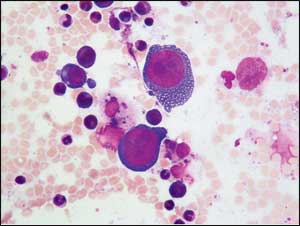- Home
- Editorial
- News
- Practice Guidelines
- Anesthesiology Guidelines
- Cancer Guidelines
- Cardiac Sciences Guidelines
- Critical Care Guidelines
- Dentistry Guidelines
- Dermatology Guidelines
- Diabetes and Endo Guidelines
- Diagnostics Guidelines
- ENT Guidelines
- Featured Practice Guidelines
- Gastroenterology Guidelines
- Geriatrics Guidelines
- Medicine Guidelines
- Nephrology Guidelines
- Neurosciences Guidelines
- Obs and Gynae Guidelines
- Ophthalmology Guidelines
- Orthopaedics Guidelines
- Paediatrics Guidelines
- Psychiatry Guidelines
- Pulmonology Guidelines
- Radiology Guidelines
- Surgery Guidelines
- Urology Guidelines
A Case of Parvovirus B19 Infection reported in NEJM

A Case of Parvovirus B19 Infection has been reported in NEJM. Dr. Marika Mende, M.D. at Universitätsklinikum Carl Gustav Carus, Dresden, Germany and colleagues have reported the case.
Parvovirus B19 (B19V) is a single-stranded DNA virus of the family Parvoviridae and genus Erythrovirus and its infection is common worldwide. Seropositivity rates are 5-10% among young children (aged 2-5 years), increasing to 50% by age 15 years and 60% by age 30 years.
According to history, a 67-year-old woman presented to the emergency department with a 6-week history of progressive exertional dyspnea. Her medical history was notable for lung transplantation that had been performed 8 years earlier. Immunosuppressive medications included mycophenolate mofetil and tacrolimus. Laboratory studies showed normocytic anaemia, with a haemoglobin level of 6.9 g per deciliter (reference range, 11.9 to 17.2). The hemoglobin level had been 12.7 g per deciliter 6 weeks earlier. White-cell and platelet counts were normal. The reticulocyte index was 0%, which aroused concern for red-cell aplasia or aplastic anaemia. Bone marrow aspiration was performed and showed normal granulopoiesis and megakaryopoiesis, but reduced erythropoiesis. Giant proerythroblasts with basophilic and vacuolated cytoplasm, uncondensed chromatin, and large, intranuclear, purple-colored viral inclusions were present on the aspirate. These findings supported a diagnosis of parvovirus B19 infection, which was confirmed by polymerase-chain-reaction testing. The patient was treated with red-cell transfusions and intravenous immune globulin.
At the time of hospital discharge, her haemoglobin level had increased, and at a 6-month follow-up, the anaemia had completely resolved.
Polyarthropathy syndrome is mostly seen in adult women with acute infection of Parvovirus B19. Patients develop acute symmetric arthritis affecting the small joints of the hands and feet, typically lasting for 1-3 weeks. For this reason, parvovirus B19 infection should be considered in the differential diagnosis of newly diagnosed rheumatoid arthritis.
For further reference log on to DOI: 10.1056/NEJMicm1807156

Disclaimer: This site is primarily intended for healthcare professionals. Any content/information on this website does not replace the advice of medical and/or health professionals and should not be construed as medical/diagnostic advice/endorsement or prescription. Use of this site is subject to our terms of use, privacy policy, advertisement policy. © 2020 Minerva Medical Treatment Pvt Ltd